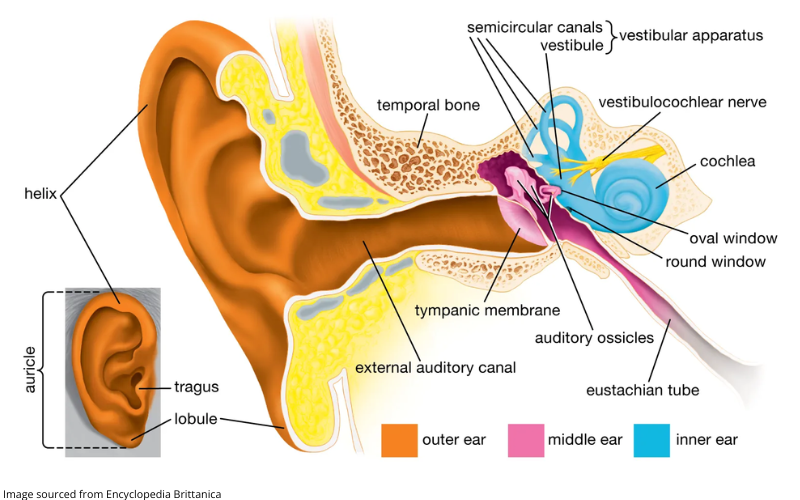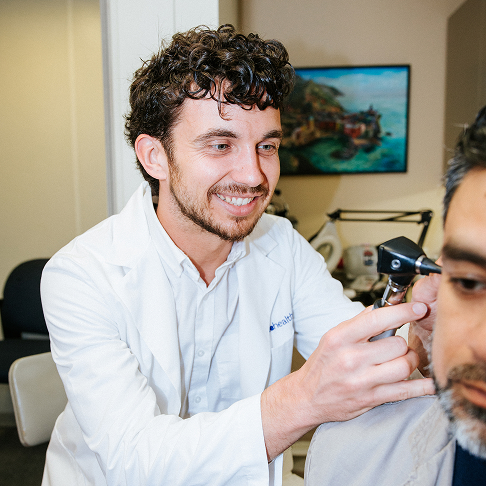Diseases of the ear may not immediately bring to mind any specific images or concerns. While ear infections are among the most frequently encountered issues affecting the inner, middle, and even outer ear, they are just one of several possible conditions that can affect this vital sensory system in the body. In the following sections, we will outline some of the most prevalent ear conditions and diseases, along with their treatment options and their origins.
Anatomy Of The Ear: An Introduction

The human auditory system is typically divided into 3 separate parts and as a whole, these make up the hearing pathway, or auditory pathway. Each separate-but-linked portion of the ear plays host to a different condition or series of conditions, ranging from the tiny bones within the middle ear to the outermost portion of the ear canal in the external ear.
Sound travels through each portion of the auditory canal before reaching the auditory nerve and ultimately being translated into recognizable sounds. First, sound travels through the air in waves and enters the pinna (or the external ear), before being funneled toward the tympanic membrane (or ear drum) via the external auditory canal (ear canal). This membrane vibrates, activating the 3 ossicles within the middle ear, which further break down the sound wave and send it to the fluid-filled inner ear. Displacement of the fluid activates the hair cells within the inner ear, leading to a chemical reaction, triggering the hair cell to send an electrical impulse to the nerve system within the ear. Nerve impulses are then conducted up and through the auditory nerves into the brain’s cortex, where sound is processed.
Sensorineural hearing loss occurs when the hair cells, nerves, or processing centers are no longer functioning properly, and is considered irreversible. Conductive hearing loss describes the mechanical portions of the auditory system, primarily those found in the middle ear. It is frequently reversible. Mixed hearing loss describes both of these conditions working in tandem, making it possible to resolve some of the source of hearing loss.
The Outer Ear And Its Conditions
The outer portion of the ear is the portion that is most readily visible to the naked eye, made up of the pinna and the beginning of the ear canal. It is responsible for the first step of hearing, which effectively traps and funnels sound waves into the tympanic membrane separating the external ear and the middle ear. Some of the more common conditions affecting this portion of the ear have been identified below.
Swimmer’s Ear

Swimmer’s ear, a condition also known as otitis externa, is an infection within the ear canal. Its name comes from its frequent association with swimming, as moisture left within the ear can lead to bacterial growth. The most common symptoms associated with swimmer’s ear include redness, ear pain, and draining fluids or discharge. Swimmer’s ear should be treated quickly upon symptom onset, as it can quickly and easily spread to other tissues and bone. Typically, these ear infections are treated with ear drops.
Cerumen (Wax) Occlusion
Although wax occlusion might not typically be considered among diseases of the ear, large amounts of wax can lead to hearing loss and discomfort–and ear disorders that come along with these issues. Cerumen (ear wax) is produced by glands in the ear canal in order to lubricate the skin in your ear, preventing it from becoming too dry, and guard against germs. A little bit of ear wax is normal and healthy. When enough cerumen builds up in the canal, however, and it is blocked, hearing and discomfort occurs, leading to the need for professional intervention. This can come in the form of over the counter drops designed to soften ear wax, or a healthcare provider. People who produce a lot of wax as a matter of course can even schedule recurring appointments to make sure wax is removed on a consistent basis.
Foreign Objects
Any object located within the ear canal that does not originate there is considered a foreign object, and requires removal. A commonly found foreign object is the tip of a cotton swab (which are never recommended for ear cleaning). Foreign objects can be the root of pain, hearing loss, and ear infections. Unlike occlusions caused by natural means like an abnormal bone growth, a foreign object can typically be easily removed by a healthcare professional.
Middle Ear
The middle ear is also potentially home to ear infections and ear disease, though the types of ear infections found there are different. Rather than finding Swimmer’s ear, you will find conditions and infections involving the ossicles, the small bones found in the middle ear, and the Eustachian tubes, or the thin, fluid-filled tubes leading from the middle ear to the back of the nose and throat. The bones within the middle ear are stimulated by sound waves, and help further break down sounds to be sent along to the inner ear.
Otitis Media
Ear infection in the middle ear is related to otitis media, and may be more common than external ear infections. Children are more likely to be affected by otitis media, due to the layout of Eustachian tubes in childhood. When pressure builds up in the middle ear space as a result of Eustachian tube dysfunction, mucous fluid accumulates and may become infected. The most common symptoms of infection include pain, loss of hearing, fluid drainage, and fever. Rather than ear drops, antibiotics are typically the preferred method of intervention.
Eustachian Tube Dysfunction
Although this type of dysfunction is often related to otitis media, it can be its own separate issue or ear condition. Its status as a conduit between the ear, nose, and throat makes it susceptible to different issues. These tubes are intended to regulate pressure within the middle ear; however, when it is not opening and closing properly, it is called eustachian tube dysfunction. People with this condition report hearing their own voice echoing and sensations of pressure or fullness within the middle ear. Many providers suggest nasal sprays or drops to alleviate symptoms.
Otosclerosis

The three bones found in the middle ear (called ossicles) are connected to each other and vibrate against each other in order to transmit incoming sound waves to the inner ear. When the bones become fused together, their mobility is limited, and otosclerosis is diagnosed. Genetics can be at the root of otosclerosis, so many family members will have the condition simultaneously, or in succession. Otosclerosis can be managed surgically, or using hearing aids. Hearing aids are less invasive, while surgery can more thoroughly address the concern and reduce the need for external help like hearing aids.
Cholesteatoma
A cholesteatoma is a benign growth that develops in the middle ear, behind the eardrum. Someone with this growth may experience symptoms such as ear pain, hearing loss, feelings of fullness and pressure, and dizziness. All of these symptoms can mimic other ear diseases or infections, making it important to speak to a health professional to receive an accurate diagnosis. Surgery is typically required to manage a cholesteatoma.
Inner Ear
The inner ear is the innermost portion of the ear. It is home to the semicircular canals, the cochlea, and the vestibular system, which is responsible for balance. The inner ear is filled with fluid and hair cells; when sound waves enter the inner ear, fluid shifts and hair cells move, preparing sound waves to be sent up a cranial nerve and into the brain for processing and interpretation.
Meniere’s Disease
Meniere’s disease is a condition affecting the ears that can range in severity from mild to debilitating. It is a condition characterized by a host of different symptoms, which are collectively identified under the same name, but all involve the endolymph, or the fluid present within the inner ear. Tinnitus, hearing loss, ear fullness, and dizziness are all standard symptoms. Medications and lifestyle modifications can both be used to address Meniere’s disease. ENT doctors are often responsible for treatment delivery.
Idiopathic Sudden Sensorineural Hearing Loss
Although sensorineural hearing loss often develops slowly, over time, it can also develop suddenly and without a distinct or recognizable cause. This condition is called idiopathic sudden sensorineural hearing loss. A virus may be at the root of its development, and is typically considered an otologic emergency. Idiopathic sudden sensorineural hearing loss is usually managed with steroids following onset, but recovery is not always guaranteed, and symptoms may be long-term.
Acoustic Neuroma/Vestibular Schwannoma
Acoustic neuromas are benign, slow-growing tumors on the hearing nerve. The symptoms of having an acoustic neuroma include hearing problems, tinnitus, and dizziness. Because it involves a growth, an ENT provider should be enlisted for help; after all, this is not the type of condition that can be addressed using home-remedies or over-the-counter interventions. Radiation and surgical treatment options do exist to help reduce the size of tumors or eliminate them altogether.
Age Related Hearing Loss

Age-related hearing loss (presbycusis) is a common form of hearing loss. As people age, the hair cells within the inner ear responsible for the transmission of electrical energy to hearing nerves become damaged and ineffective. This is a large part of why hearing loss is more common in older adults than younger adults. Presbycusis often comes on gradually, and may not be easily recognized. Treatment involves hearing aids and communication strategies to combat any communication disorders and issues with communicating that may arise.
Treatment For Diseases Of The Ear
Treatment options for hearing diseases and disorders vary somewhat; the type of disease or disorder will greatly inform the type of intervention required. Hearing aids are commonly used to address general hearing loss, tinnitus, and even some communication disorders. Cognitive Behavioral Therapy (CBT) can help people with hearing diseases and disorders develop coping methods to deal with the possible emotional fallout of hearing loss. Surgery, medication, and more can all be used to treat ear infections and growths, while tinnitus treatment and other disorders of the ear may involve a varied and multi-pronged approach.
Next Step: Book Free Consultation
- 75% of patients reduced their tinnitus within three months after following our recommendations.
- "I feel like Treble Health literally gave me my life back." - Randy S. (verified customer)
- Join thousands of people who have reduced their tinnitus after scheduling a free consultation.















